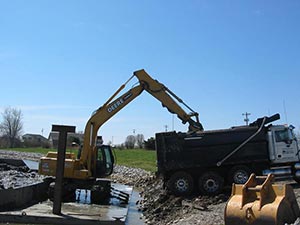Are you considering hiring a contractor to dredge a waterbody on your property? According to Section 404 of the Clean Water Act, anyone intending to dredge one of our nation’s waterways must first obtain a permit to do so.
Our dredging contractors have years of experience in navigating this process. Here’s what you need to know about how to obtain a dredging permit in Indiana. Continue reading to learn more about obtain dredging permits in Indiana.
How Permits are Distributed
Dredging permits are distributed by the U.S. Army Corps of Engineers. When the Corps of Engineers receives your application, they will look at the possible pros and cons for your dredging project. Your permit might be denied if dredging will do more harm to the environment than good, or if you don’t have the resources to do it successfully. That’s why it’s important to hire professional dredging contractors to do the work for you.
Permits are required because the Corps of Engineers wants to make sure that dredging a waterway won’t harm the environment in any way. This means you need to make sure that your dredging project won’t disturb any toxins or introduce waste to a new environment.
For example, you can’t dredge silt out of the water only to leave it on the shore. You need to take the proper precautions and ensure you have a place to dump whatever you’re dredging. If you’re dredging silt and sediment, the best place is usually an open field with erosion fencing to prevent the silt from blowing around.
What to Include on the Application
In your application for a dredging permit, you’ll have to include every detail about your plan for the dredging project. This includes your name and contact information, the name and location of the waterbody you’d like to dredge, the reasons for the dredging and the materials that will be dug out, and where you plan to dump the materials, as well as what you’re doing to minimize the environmental impact of the dredging process.
You’ll also need to include any approvals or permits from other agencies that might be required for your project and the contact information of the surrounding property owners. Lastly, you will need to include three illustrations: a vicinity map, a plan view, and a cross-section. These can be hand-drawn or created digitally.
Once you submit your application, the Corps of Engineers will consider the information and will either grant you a permit or deny your application. If you’re denied, you can appeal the decision if you have a solid claim that your dredging project would benefit the environment more than it would cause harm.
At McCullough Excavating, our team of dredging contractors has years of experience in dredging ponds, lakes, streams, and other waterways. For your next dredging project, give us a call at (765) 386-6514.

